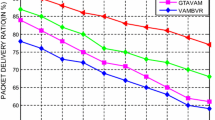Abstract
Vampire attacks are considered to be the most vulnerable resource draining attack that is potential in disabling the connectivity of the network by draining mobile node’s energy at a faster rate. This vampire attack is generic as they exploit the characteristic features of the base protocol used for enabling communication in mobile ad hoc networks (MANETs). The core objective of this paper is an attempt to formulate an energy forecasting mechanism using grey theory that ensures reliable network connectivity that gets influenced through the vampire behaviour of mobile nodes under active communication. This Semi-Markov chain-based grey prediction-based mitigation (SMCGPM) is an enhanced Markov chain model that integrates the characteristic features of stochastic theory and grey theory for improving the efficacy in detecting a specific kind of vampire attack called as stretch attack. In this technique, the elucidated data from each mobile node are initially modeled based on Grey model. Then, the residual error is calculated between the forecasted and observed values of energy possessed by the mobile nodes based on their packet forwarding rates. SMCGPM has the capability of predicting the possible transition behaviour of mobile nodes through the estimated residual error derived from the Markov chain matrices. Simulation results confirm that SMCGPM is predominant than the baseline prediction schemes by facilitating an effective detection rate of 29% as they achieve correctness and accuracy in prediction through Semi-Markov chain stochastic properties inspired energy factor prediction.











Similar content being viewed by others
References
Rizvi, S., Elleithy, M.: A new scheme for minimizing malicious behavior of mobile nodes in mobile ad hoc networks. Int. J. Comput. Sci. Inform. Secur. 3(1), 25–34 (2009)
Kariya, S.L., Panchal, B.B.: Selfish nodes detection in MANETs: acknowledgement based approach. Int. J. Sci. Res. 2(5), 216–217 (2012)
ArunKorath, D., Vineeth, K.V.: A survey on detecting selfish nodes in wireless sensor networks using different trust methodologies. Indian J. Appl. Res. 4(1), 193–194 (2011)
Patel, A.A., Soni, S.J.: A novel proposal for defending against vampire attack in WSN. In: 2015 Fifth International Conference on Communication Systems and Network Technologies, vol. 2, no. 1, pp. 22–29 (2015)
Patel, A., Patel, N., Patel, R.: Defending against wormhole attack in MANET. In: 2015 Fifth International Conference on Communication Systems and Network Technologies, vol. 3, no. 1, pp. 45–56 (2015)
Yan, S., Liu, S., Liu, X.: Dynamic grey target decision making method with three-parameter grey numbers. Grey Syst. 6(2), 169–179 (2016)
Kaur, V., Rani, P., Singh, D.S.: Vampire attacks: exploration & consequences. Int. J. Sci. Eng. Res. 7(4), 1203–1207 (2016)
Damayanthi, D., Singh, M.: Prevention of vampire attacks in wireless sensor network. Int. J. Comput. Appl. 154(9), 19–20 (2016)
Yan, S., Liu, S.: Multi-stage group risk decision making with grey numbers based on grey target and prospect theory. Grey Syst. 6(1), 64–79 (2016)
Singh, J., Kaur, S., Kaur, G., Kaur, G.: A detailed survey and classification of commonly recurring cyber attacks. Int. J. Comput. Appl. 141(10) (2016)
Hernandez-Orallo, E., Serrat, M.D., Cano, J.C., Calafate, C.T., Manzoni, P.: Improving selfish node detection in MANETs using a collaborative watchdog. IEEE Commun. Lett. 16(5), 642–645 (2012)
Subramaniyan, S., Johnson, W., Subramaniyan, K.: A distributed framework for detecting selfish nodes in MANET using record- and trust-based detection (RTBD) technique. EURASIP J. Wirel. Commun. Netw. 2014(1), 205 (2014)
Wang, F., Mo, Y., Huang, B.: COSR: cooperative on-demand secure route protocol in MANET. In: International Symposium on Communications and Information Technologies, vol. 4, no. 1, pp. 11–18 (2006)
Chen, T.M., Varatharajan, V.: Dempster-Shafer theory for intrusion detection in ad hoc networks. IEEE Internet Comput. 9(6), 35–41 (2005)
Akhtar, M.A., Sahoo, G.: Humanistic approach in mobile ad hoc network: HAMANET. Comput. Sci. Inform. Technol. 1(2), 45–52 (2013)
Nisha, A.S., Vaishali, V., Shivaranjani, T., Subathra, P.: The effect of vampire attacks on distance vector routing protocols for wireless ad hoc sensor networks. In: Second International Conference on Science Technology Engineering and Management (ICONSTEM), Chennai, pp. 587–594 (2016)
Deshmukh, L.R., Potgantwar, A.D.: Ensuring an early recognition and avoidance of the vampire attacks in WSN using routing loops. In: IEEE International Advance Computing Conference (IACC), vol. 2, no. 3, pp. 12–24 (2015)
Khalil, I., Bagchi, S., Shroff, N.: LITEWORP: a lightweight countermeasure for the wormhole attack in multihop wireless networks. In: International Conference on Dependable Systems and Networks (DSN’05), vol. 2, no. 1, pp. 16–23 (2005)
Santhya, K.: Energy consumption of High Power MANET Using LVC. Int. J. Eng. Comput. Sci. 3(2), 23–37 (2017)
Begum, M.Y., Deepalakshmi, M.G.: Improving the QOS In MANET using dynamic efficient power consumption based congestion control scheme. Int. J. Eng. Comput. Sci. 4(02), 12–24 (2016)
Author information
Authors and Affiliations
Corresponding author
Rights and permissions
About this article
Cite this article
Srikaanth, P.B., Nagarajan, V. Semi-Markov chain-based grey prediction-based mitigation scheme for vampire attacks in MANETs. Cluster Comput 22 (Suppl 6), 15541–15549 (2019). https://doi.org/10.1007/s10586-018-2698-6
Received:
Revised:
Accepted:
Published:
Issue Date:
DOI: https://doi.org/10.1007/s10586-018-2698-6




